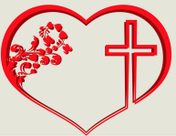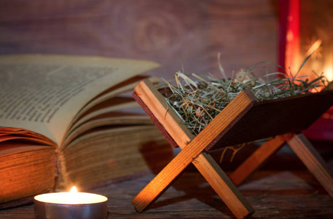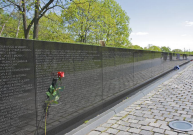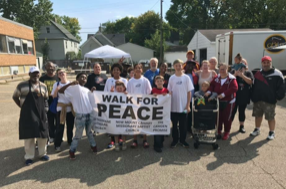|
by Pastor Barb
I’ve been thinking a lot about life lately—its meaning and purpose, and how God might view it—no doubt because I’ve had to think a lot about death lately as well. We’ve said goodbye to our beloved Dale Szach, to our friend Larry Vance, and to other friends and family members of our congregation and those of our mission partners. We’re reminded that life is definitely a fatal condition. The circumstances of a death really matter to us, and affect the way we grieve. We might feel peace when death comes gently after a long life, or feel anger when a life ends too soon, or is cut short by tragedy. Sometimes a focus on the circumstances of death can distract us from a more essential focus: on the circumstances of life. Jesus came that we may have life, and have it abundantly (John 10:10). So maybe our effort could be to figure out what having “abundant life” really means. It can’t just be about material wealth, because we know of rich people who are lonely and miserable. It can’t just be about longevity, for the same reason. Then what’s it about? For me, it’s all about relationship. Because God is all about relationship. We are launched into the world with a few loving relationships, if we’re lucky: family and close friends. They are the roots. As we live and grow, our relationships grow as well. If we tend nurture them, they deepen and strengthen and become a more firm foundation for all that is growing and thriving above the surface, so that it can grow bigger and broader. The web becomes more intricate with more dimensions, and eventually it becomes so strong that nothing can break it. It’s the kind of web that structures our lives, as we go about our work and our leisure. It is our safety net in times of trouble. At those times of life when we start to sink downward, it catches us. And it flexes, so the harder we fall, the more it enfolds us, wraps itself around us, and holds us tight. So we never fall too far; we’re never in free-fall where we can’t see the bottom. That web of relationships, held together by love, is always there. Even when death comes, we have it to hold onto. Because bodies fail, and people die, but love never does. The love we have shared with a person who dies is ours forever, to cherish and to share again. Love is the only thing that grows larger, the more we give it away. Life lived in the comfort and support of such a web of relationships is abundant life. And such a life is of God. It grows out of that part of us that’s made in the image of God. We are taught: love God, and love one another. Relationships are what God is all about; what God seeks to have with us, and how God wants us to live with one another. It’s what we were created for. It’s what gives us life. Because God is all about relationship. You might see, as I do, that in the world around us this way of life is to be treasured, because it is becoming more and more rare. Too many people live in isolation, leaning on the Internet or the TV for solace. Or the pursuit of other forms of abundance precludes loving relationships. Or, perhaps they were not lucky enough to be born into love, and so they have to struggle to figure it out as they grow. And some never do. So maybe, when we see people who are not living in such abundance, we can become part of their growing web. We can add to their riches by entering into loving relationship with them, and helping them to see the love around them, and tend and nurture it, so it can grow. Then they too might have life, and have it abundantly.  by Pastor Barb The new year brought good news: the Epiphany of our Lord; the season when the true identity of the baby in the manger is revealed. He is the Christ, the long-awaited Savior. We learn this through the Magi. Then, as the story unfolds in the weeks after Epiphany Sunday, the news is affirmed by the Holy Spirit descending as a dove and the voice of God claiming Jesus at his baptism, and by his healing of the sick by calling on the power of the God. In these and other ways, it slowly dawns on us that God has truly come to abide among us. He has come to build the Kingdom of Heaven right here, through Jesus, and this savior is for all of us, every one. This is the fulfillment of the ancient promise; the embodiment of what the prophets foretold. “Hold on,” they said; “salvation is coming. You will be all right. Just keep the faith.” And in the tiny child in the manger, and in the young man who launched his ministry by making broken people whole, the promise is kept. God is faithful. God comes through for us. Today, we surely need the good news of Epiphany just as much as our faith ancestors did. God remains faithful, but our own faith may be sorely tested by the troubles around. Political strife, community violence, the Corona virus, actual shooting wars, and all the problems that seem to threaten the future might make us wonder where God has gone. So, we can look ahead, and be reminded of just where God is. As we approach the transition from Epiphany to Lent, we note the halfway mile-marker between Christmas and Holy Week. The 40 days of Lent begin with Ash Wednesday. We fall to our knees, and confess that we are sinners. With the ashes of palm leaves, the cross of Christ is traced on our foreheads, just where we were marked with the cross in baptism, to remind us that we are dust, and to dust we shall return. During Lent we are reminded of who we are, and who God is. And that tells us just where God is: right here among us. Marching toward Jerusalem. Preparing us for the cross. Throughout the 40 days of Lent, our foreboding grows. The world’s troubles will continue, and Jesus will come ever closer to Calvary. We cannot avoid Good Friday, but Easter Sunday will follow. So we can draw once again upon the voices of the prophets: “Hold on. Salvation is coming. You will be all right. Just keep the faith.  by Cindy Nehrbass “Tin-foiled” chocolate hearts, and crunchy sugar sweet-tarts with typed messages requesting affection “Be Mine”, “Hug Me” taped to store-bought Dora the Explorer and Pokemon cards (or in my day it was Charlie’s Angels and Scooby Doo)...handwriting three-dozen names of our children’s classmates—must make sure to include everyone — on your long Valentine-to-do-list. Handmade cards for grandma, lonely friends, your spouse. Flowers, special dinners, phone calls, and hearts everywhere—covering Facebook, and dangling from store ceilings. Each February we dedicate a day to show those around us that we care by asking them to, “Please be our Valentine?” But does God get a special mid-winter “Valentine” from us too? February 14th, was originally a day to honor St. Valentine, a third-century Roman saint commonly associated with “courtly love” who supposedly helped free Christians from prison during times of persecution, by professing his faith through action. Rumor has it that, while St. Valentine was under arrest for trying to convert people to Christianity, the judge asked him to prove the validity of Christ by healing his blind daughter. Faithful Valentine placed his hands on the eyes of a judge’s daughter, and in Christ’s name her sight was restored. This miracle brought the judge to Christianity and he was baptized along with his 44 family members. In gratitude, the judge also freed all of his Christian inmates. But was Valentine’s Day, ever a Christian holiday? Not really, only in as much as the Catholic church made special days to honor saints. And in 1969, the Roman Catholic Church even removed St. Valentine from the General Roman Calendar, because so little is really known about him. However, the church still recognizes him as a saint, listing him in the February 14th spot of Roman Martyrology. So what if next year we were to make St. Valentine’s day a special day to express our own faith in Christ —like Valentine out loud to others and in our actions — so they might hear the good news and be freed from their own personal prisons and bondage from sin and fear? What if we were to declare our true love and ultimate “Valentine” be Christ, by performing acts of kindness on His behalf? Saying, “Christ, please be mine.” Because Christ has already responded, “I am yours.” His life, and ultimate death on the cross, the biggest expressions of love to us all.  by Pastor Jeff To everyone who has, more will be given and he will have an abundance. But that one who has nothing even what he has will be taken away" Mt 25:29 - The parable of the talents Imagine looking under the Christmas tree one Christmas and seeing a mountain of presents.....it looks as though there are presents for everyone in your family and enough to make even the grumpiest child happy. The presents are big and they are wrapped beautifully. There are huge bows on each one of them and a card with with the names to whom they are about to be given. And there are five presents with your name on the cards! Huge presents! Well wrapped and ready to be opened by you....everyone in the family is excited. Your siblings are jumping up and down! One by one each of the presents gets opened.....except yours. Your siblings are excited! They are looking at their presents, playing with their presents, learning how to use their presents... But you have decided not to open yours. Why? Can't you see how much fun your siblings are having with the gifts that have been given to them? The joy in their hearts and in their eyes as they play with one another with the gifts that have been given them? Your brothers and sisters look at you like there's a screw loose in your head. Who wouldn't want to open such magnificent gifts as these? It is so much fun guessing what is inside and then ripping the paper open! It's a blast to learn how to use the gifts that have been given to you. And it is so much fun sharing what gifts you have and playing together with your brother and sister. Your parents are confused too. They went out together to secure just the perfect gifts for you. Gifts that reflected your personality and style. Gifts that would help you become more of who you are and bring joy to your life and your world in using them. But apparently..... you prefer to look at your gifts. To simply admire the way that they're wrapped. To know that your parents gave you the best gifts in the world but not know exactly what they are. Then you hide them away in the basement closet thinking that maybe 30 or 40 years from now you can pull those presents out and show your parents that you still have them. Certainly your parents will be impressed that you still have these gifts just the way they were given to you - unopened, unused, still with the pretty paper, card and bough........right? God (and the children of God too!) scratches his head a lot about you and I when God thinks about all the gifts God gives each one of us. Such beautiful gifts, given with care and attention to detail. Gifts that reflect our personality and style. Gifts that would help us become more of who we are and bring joy to our life in using them. But we leave them unopened, undiscovered, un-played with. We hide God's gifts away, thinking that if we can just keep the gifts of God looking the way God gave them to us that it will count for something. But it doesn't count. Not for anything. Unless you open and use the gifts that God has given you, all that present is is an unused future life of joy - a life that could have been- wrapped up in a pretty box. Have you opened all your presents? Ripped open the paper and learned how to use all the cool things God has given you? Shared your joy with the world full of other people who are sharing their joy with the gifts that God has given them? Remember, to those who have received many gifts, even more gifts -joy, satisfaction, community-will be given in using those gifts. But if you never open your box, forget about the extra gifts. Because if you don't open the box it will feel like even the gifts God give you are being taken away… Christmas Blessings, Pastor Jeff  by Pastor Barb It was a Saturday, like many others. Our Violence Prevention Youth Group was at church, doing some cleaning and other tasks to improve the environment in our building. Then they went over to North Market for lunch, and talked about their ultimate goal: violence prevention. After lunch they scattered homeward. Over half of the group lives in the same building, a few blocks from church. There are a lot of kids in the building, and their play space is the yard around them. On this typical Saturday evening, some kids were outside playing. Some of our youth were in their apartment watching a movie, with their younger siblings. They heard gunfire. It sounded like it was about a block away. Then they heard cars screeching, coming nearer. Then more gunshots. Then a loud boom. Out the window, they could see that the boom had been a car crashing into the building next door. A man got out of the car and ran toward the alley. Another car crashed into a parked car. Finally, sirens. A police car, an ambulance. Flashing lights. And a body on the ground. All of this took place within clear view of the apartment windows. The kids outside saw even more. When the first shots rang out, our youth who’d been watching a movie asked if they should get on the floor. That was their first reaction. What does that tell us? That they’ve been through this before; that they understand gun violence as part of their environment; that they know bullets sometimes come through apartment walls. Had they seen a body on the ground before? Or how the first responders or the coroner deal with the scene? More importantly, what effect does it have on adolescents and younger children to witness such things? Have they developed a “been there, done that” attitude, or are they traumatized by what they’ve seen? Both are problems for their development and well being. If we need any more reasons to work to end violence in our community, here’s a big one: for the sake of the children. Since last winter I have been learning about the effects of “adverse childhood experiences” (ACES) on children and youth. This effort was motivated by the kids around me, what they said; what I saw in their behaviors, and in the reactions of adults around them. I was troubled that frequently, when kids would “act out” in public, people would assume that something was deficient in the kid, or that their parents were inept. I’ve learned some important things in the past year. Here are two important ones: (1) There are no purposeless behaviors. If a kid (or anyone) acts out, it’s a way of expressing something, when one knows no other, more constructive means of expression. (2) Instead of thinking, “What’s wrong with you?” about that person, maybe we should think, “What happened to you?” And, far too often, what has happened to a kid who is acting out is some form of adverse experience, or trauma. In our community, simply living with the awareness of gun violence around them is an adverse childhood experience. Knowing that there is risk of harm in going outside to play, walking home from school, or any other ordinary daily activity is itself traumatic. This is not just emotional damage. The chemicals that the body releases in response to trauma involve the brain in negative ways. If these chemicals wash through the body too often, the developing brain of a kid will change in ways that can affect behavior. If these effects aren’t recognized and addressed, a kid can grow up to be an adult who acts out. The anger, distress, fear, frustration, and all the other pent-up things that early trauma generates will emerge in some way, sometime. I have no doubt that a lot of people who sit in prison today ended up there because their “stuff” emerged in anti-social ways. As one local resident said recently, after hearing of a violent event that took place in front of kids, “I see kids in my community traumatized over and over again…and they never get help dealing with the emotional toll. They grow up to be angry, hurtful people.” There is good news arising out of this day as well. In the building where so many witnessed the events of this day, the residents came together for a meeting with building management. The immediate response would be to send in therapists and counselors to help witnesses to process what they’d seen. The longer-term response would be to consider more safety features like motion-detector lighting, effective fencing of the yard, etc. And, there is interest in holding another meeting. Because we are organized for violence prevention, that meeting is likely to be held at The Camden Promise. All of the youth in our violence prevent group have witnessed or experienced violence. Some of them witnessed it on this Saturday. These young people have parents who are knowledgeable, concerned, and involved. They talk with their kids. Because we have a violence prevention group, the youth also have had opportunities to speak openly, together, with caring adults (some of whom are city and state officials), to process what they’ve seen, to find common ground, to share common experiences, and to think creatively about solutions. These include directing the energies of the youth into positive, constructive engagement and service in the community. A supportive community infrastructure is being built, one step at a time, to support and strengthen residents against violence and trauma, and ultimately to put an end to the violence altogether. This is for the benefit of the whole community; but, most of all, it is for the children.  by Pastor Barb The writer Aldous Huxley said, “After silence that which comes nearest to expressing the inexpressible is music.” Hymns and choral music are at the heart of Lutheran tradition. When mere words are not enough, raising our voices together in song elevates our words into art and prayer, and sends them heavenward. Most of the time, Lutheran hymns are strong on praise, recounting the history of God’s work, giving thanks, and testifying to God’s faithfulness and our own efforts to be faithful. When Advent begins, the music takes a sudden turn, to a minor key. The plaintive cries of “O Come, Emanuel” reveal our yearning, our need, and our hope. We revisit God’s promises, as foretold by the prophets, of a messiah, a savior, and we cry out to God to see that promise fulfilled. “O come, O come, Emmanuel, and ransom captive Israel, that mourns in lonely exile here, until the Son of God appear.” These days, we might feel that need more than ever, because our world sometimes seems to be spinning out of control. I love the music of Advent, especially the “O Antiphons,” from which the verses of “O Come Emanuel” are drawn. The antiphons are centuries old, and in some traditions are recited as prayers each day in the last week of Advent. Each begins with “O”, which adds to our sense of urgency and desperation in crying out for a savior. Each uses a different title for Jesus, and so they remind us of all that God will do through Christ, when he comes. Each ends with an “ask”: “Stretch out your hand; show us the way; lead us to freedom.” For me, singing these in a minor key conveys the sense that we, too, “mourn in lonely exile here,” as we yearn for the promised messiah. Advent is a wonderful time for daily devotions. Consider praying these O Antiphons each day from December 17 to 23. Find the verse of “O Come Emanuel” that draws on that day’s prayer. Then, ponder how God might already be actively at work, doing what we have asked for. Think about what you see in the world that might be signs of God’s activity. Share your thoughts with family. Invite the kids to participate. Have the neighbors over to talk. Advent is a time of active waiting. As we wait, we prepare ourselves for the time when the promise is fulfilled: for the coming of the Christ child. BY Pastor Barb
During the program year we gather around a table in Fellowship Hall after worship each Sunday for Confirmation class. This year we’re being “intergenerational”—adults are invited as well as youth, not as supervisors or teachers but as learners along with our young people. “Confirmation” may seem like a funny word to use for a faith milestone. In baptism we receive the gifts of the Holy Spirit. The community of faith—the congregation, our parents, and our “sponsors” or godparents—promise to support our faith development: to see that we will “live among God’s faithful people, bring us to hear the Word and receive Holy Communion, teach us the Lord’s Prayer, the Ten Commandments, and the Creed, put Scripture into our hands, and nurture us in faith and prayer so that we may learn to trust God, proclaim Christ through word and deed, care for others and the world God made, and work for justice and peace.” So, it might be easier to understand the Confirmation rite as an “Affirmation of Baptism.” When we reach a certain age and have engaged in a certain amount of preparation, we are ready to take on responsibility for these promises ourselves—to claim full ownership of our own growing faith, and of our own relationship with God. Our congregation invites any who are interested to join in, whatever your age. With diverse perspectives around the table, we’ll talk about life (and death), faith and doubt, and bring our deepest questions. And we’ll develop our skill at seeing God in the midst of all of it. You are invited! *  By Pastor Barb Recently I attended a seminar on “natural” or “green” burial. I’d been hearing about this growing trend for a while, and wanted details. The speaker reviewed the history of burial traditions and beliefs, some of which focused on the need to bury the body intact, in anticipation of “the resurrection of the body.” This was futile, I thought. Try as we will, there is no reasonable way to preserve a body intact after death. I recall visiting Lenin’s tomb when I was in Moscow many years ago. His body was laid out under glass for viewing, and preserved by coating him with layers of wax from time to time. But it was clear that most of what we were seeing was not Lenin, but just the wax—the superficial evidence of a wish to hold on to something that was lost. In that case, the Soviets made an icon out of one of their founders, by venerating his body. The casket of royalty or a church leader that bears the likeness of its occupant on its lid has a similar purpose. We can visit them and imagine we are in the presence of those great people. It’s a little like relics. Tiny remnants of bones thought to belong to an apostle draw pilgrims by the thousands. Or, perhaps it’s like the feeling we might have if we had met a Civil War veteran. We want to look into the eyes that have looked into the eyes of Lincoln. Keeping Grandma’s lace hanky or grandpa’s favorite pipe serves the same purpose. We find meaning in these things—in connecting across time and space to something we value, something good; something that’s been lost. In many places across the world, headstones have photographs of the deceased etched into their surfaces. If you’ve ever visited the Vietnam memorial in Washington DC (pictured below), you might know the power of having the names of those lost etched into that wall. People run their fingers over the indentations that form the letters, and feel connected to their loved ones. These efforts to stay connected are perfectly natural, and human. They help us in our grief, and ease our sense of loss. But they are limited, and finite. We might lose Grandma’s hanky or misplace Grandpa’s pipe. The eyes of the last Civil War veteran closed long ago. Then how do we stay connected, forever? As I listened to the seminar speaker describe “green” burial, I thought how well that fits with our theology. It returns us to the life cycle of the earth from which we came, with no chemicals, no materials that will not biodegrade, and no structures that will hinder the process. And, as we are given back to the earth we nurture new growth and life. There is another cycle of life within God’s Creation that is perpetual, beyond the body. I think of it each fall as we approach All Saints Sunday, which we will observe this year on November 3. Recently I heard this described in words so beautifully that I don’t need to paraphrase it. It is associated with the Jewish prayer service called Kaddish. I believe it’s what all our loved ones who have gone before would like to say to us if they could. As you seek ways to stay connected to those you’ve lost, I commend it to you.  By Pastor Barb Recently I attended the 5-year anniversary celebration of a bilingual, Spanish-English multicultural church. Many of the people have only one language, Spanish or English, and the church has worked hard to open communication among those folks and bring them into relationship, by helping them learn one another’s languages. The guest preacher said that, in doing so, they don’t just build bridges; they cross them. In other words, they go to people, and meet them where they are. It’s not enough to just build a bridge and wait for the other person to cross, or even to meet us halfway. Maybe they can’t, or won’t, or don’t know they should. We cross the bridge to them, because we can. We meet them where they are. This is such an important part of what we need to do as church that I thought it would be worth sharing here. I began to think of other situations where walking across that bridge to meet the other person has been especially important to me. Here are just a couple of very different stories that came to mind. I’m sure you have your own as well. --Crossing bridges is what we do in worship every week. We can’t be church with a diverse community if every element of our worship is drawn from the great Lutheran traditions developed by our European ancestors. That would be them. So, alongside the traditions of Lutheranism, we don’t claim that Jesus was Nordic. We incorporate and learn traditional gospel music through the amazing gifts of Minister Beverly. And sometimes we sing and pray and dance in ways that are more familiar in the traditions of our neighbors. We are trying to meet our neighbors where they are, so that we can worship together as one family of Christ. --I have a friend who lost her 22-year-old son suddenly a couple of years ago, and grief is a part of her, always present right under the surface. It changes from day to day, even moment to moment. I never know where she will be with her grief on any given day. So, I don’t ask her how she’s doing generally. There’s no answer for that. I’ve learned to ask simply, “How’s today?” And she will tell me, and I will meet her there. Not where I would prefer to be, in a more comfortable place, but wherever she is with her grief. That’s the only way we can be in relationship: first, I cross over to acknowledge the grief that she will not bring to me. Under her circumstances, it’s not her job to cross over to my side of the bridge. It’s mine. --Then there was a moment one day recently at our food distribution. Sometimes folks who come in for food behave in ways that annoy some of the other people who are there. I thought especially of “Sam”, who often comes in altered by alcohol, which makes him loud and obnoxious and rebellious toward the rules. Occasionally he will slide an extra package of food under his jacket, beyond the allotted number. I remembered how different he was that particular day—at church before anyone else, stone-cold sober, with a seriousness of purpose that was unfamiliar. He had in his hand a certificate that said he had completed a series of classes that would allow him to seek part-time work. He was bursting with pride, and couldn’t wait to get here and show his certificate to Pastor Jeff. And, I saw his reaction later when, with the paper tucked into his jacket and just a corner sticking out, one of the volunteers asked him, “What’re you hiding this time, Sam?” The look on Sam’s face, as he reached for the paper to show it to the man, still haunts me. It was the face of a human being whose spirit is being crushed. I recognized the face, because I’ve made it myself. Maybe you have too. It’s the face we make when someone says to us, “I will always define you by your worst day. I will not meet you where you are today. I won’t even bother to find out where that is.” Low expectations are a heavy burden. And we tend to live up to expectations. I wonder if Sam went home that day and had a few drinks, trying to kill the pain of that encounter. I wonder if, next time he comes to us for food, he’ll brace himself with alcohol first so he can face people who will continue to define him as his worst self. He might think, “What’s the use; I might as well just be that person.” I’ve re-written that scene in my head a few times. What if, that day, instead of greeting Sam with suspicion, the man had said, “How’s today, Sam?” When a broken spirit raises its head and shows signs of life, as Sam’s did that day, we should rejoice. The recovering spirit is delicate and fragile, so we need to treat it with tender care and nurture it, whether in a child or a 70-year-old, like Sam. It’s been said that what we can know about a person in our usual encounters is like the tip of an iceberg. The huge part that’s hidden below the water line is what’s going on in their life. So, we should be gentle, and as kind to one another as we can be. Jesus died and rose for our redemption. All of our past sins were forgiven. We were made righteous in God’s eyes because of what Jesus did. He met us where we were, as sinners, and does so again every day. With each new day our old selves die and are resurrected. Each new day is another chance at a new life. If we build bridges and cross them to meet our neighbors where they are today, we will remain open for something new. New relationships; new life together. Maybe even a new world.  By Pastor Barb Wow, that went fast! We’re at the end of a breathlessly busy summer, and it’s time to finally take a breath and take a look back. Where’d that time go? July saw the launch of twice-monthly block parties in the parking lot. Each of these begins with a Peace Walk around the neighborhood. Then we come back for a great BBQ lunch, and end with a food distribution, with Second Harvest providing extra produce. The Peace Walks are a way to take a stand against violence in the community, and encourage our neighbors to do the same. We sing as we walk, led by Minister Beverly, or Toya Kemp of New Mount Calvary. Last year we stopped to pray at several sites where violence had occurred. This year our new Violence Prevention youth group leads the walks, carrying a banner that ways “Walk for Peace,” and wearing t-shirts that say “Live in Peace” (#lip). We walk along busier streets, and stop in at a few businesses along the way to say hello. We’ve been amazed at how many drivers smile, honk, wave, or give the “peace” sign in support when they see the group. Want to join in? You’ll have one more opportunity on Saturday, September 28. The final block party of the season will be combined with our church picnic. We’ve been promised a traditional “Lutheran church basement” dish, along with chicken drummies, beer-battered shrimp, corn on the cob, watermelon, and other surprises. Our mission partners at Mount Calvary Lutheran in Excelsior will join us, along with City Council member Philippe Cunningham and Sasha Cotton, the director of the city’s violence prevention program. We’ve also invited the Lind-Bohanon, Shingle Creek, and Webber-Camden neighborhood associations to come. So, we expect the Peace Walk to be larger than ever. On that same weekend, Sunday, September 29 is Rally Day! We’ll have worship outside under the tent (weather permitting), and be joined by New Mount Calvary partners. You’ll have a chance to sign up for Sunday School and Confirmation classes. This year Confirmation will expand to an “intergenerational” model, so families can accompany confirmands in and learn and deepen their faith together. We’ll meet right after church each Sunday. Want to know more? Talk to Pastor Barb! Our Wednesday Community Dinners have moved inside now, as the weather turns cooler and darkness descends earlier and earlier. These dinners are a great chance to meet our neighbors, enjoy some great food, and take some more food home! You’ll especially want to mark your calendar for October 16, when Attorney General Keith Ellison will join us, along with Sasha Cotton. |
Archives
March 2020
Categories |
 RSS Feed
RSS Feed
